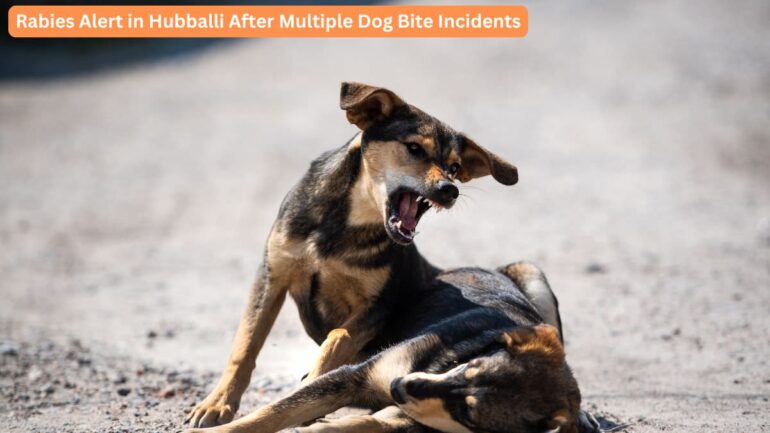- Empty cart.
- Continue Shopping
Rabies Alert in Hubballi After Multiple Dog Bite Incidents – Rabies dog attack

Rabies dog attack –
Rabies Alert in Hubballi After Multiple Dog Bite Incidents
The city of Hubballi is on high alert after a series of alarming dog bites took place, reportedly involving more than 30 individuals. Authorities are now advising residents to exercise caution and seek medical attention immediately if bitten.
Understanding the Rabies Dog Attack: How It Began
The incidents began when reports of a rabies dog roaming the streets of several Hubballi neighborhoods started to surface. Witnesses described a frantic and aggressive dog targeting anyone in its path. As news of the rabies dog attack spread, many locals took to social media to express their concerns and urge action from local authorities.

Immediate Actions Taken by Local Authorities
Upon learning of the attacks, emergency services and healthcare professionals quickly mobilized to address the situation. Here’s a breakdown of the steps taken:
- Public Warnings: Swift communication efforts were made to inform the public about the rabies dog. Announcements were broadcast through local radio stations, news outlets, and social media.
- Animal Control Teams: Animal control units were dispatched to search for the rabies dog, prioritizing the safety of all residents.
- Medical Assistance: Local hospitals and clinics were alerted to prepare for an influx of patients who may require immediate anti-rabies vaccination.
The Impact on the Community
The rabies dog attack has caused a wave of anxiety throughout Hubballi. The community, which is normally bustling with activity, has seen a notable decrease in foot traffic as people remain cautious about venturing out.
- Schools and Parks: Several educational institutions and recreational areas have temporarily restricted access until the situation is brought under control.
- Local Businesses: Shops and markets have reduced hours, with some owners expressing concerns over the safety of their employees and customers.
Rabies: A Dangerous Disease
Rabies is a deadly virus transmitted through the saliva of infected animals. It can be prevented with prompt medical intervention but is almost always fatal once symptoms appear. Here’s what you need to know to stay safe:
Preventive Measures
- Stay Away from Stray Animals: Avoid contact with stray dogs and other animals that may be infected.
- Vaccinate Pets: Ensure that your pets are up-to-date with their rabies vaccinations to prevent the spread of the virus.
- Seek Medical Attention: If bitten, clean the wound with soap and water and visit a healthcare professional immediately for a rabies vaccine.
What to Expect for Hubballi Residents
Authorities have assured the public that they are doing everything possible to resolve the crisis swiftly. However, it’s important for residents to remain informed and take necessary precautions. Here are some steps being taken to address the rabies dog attack and ensure public safety:
- Increased Patrols: Police and animal control officers will increase patrols to identify and capture stray animals.
- Community Involvement: Citizens are encouraged to report any sightings of aggressive animals to the authorities immediately.
Staying Safe and Informed
While the situation is being handled, it’s crucial for Hubballi residents to stay informed through reliable sources. Here are some tips on how to remain updated:
- Follow Local News: Stay tuned to local news channels and websites for updates.
- Use Social Media Cautiously: Verify any information received on social media through official sources.
- Participate in Community Meetings: Attend any community meetings or forums organized to discuss the ongoing situation.
Hope for a Swift Resolution
Though the rabies dog attack has sent ripples of fear across Hubballi, the collective efforts of local authorities, emergency services, and concerned citizens are paving the way for a resolution. By staying vigilant and informed, the community can navigate this crisis with resilience and ensure the safety of its residents.
As Hubballi continues to address the rabies dog issue, let’s remember the importance of prevention and community cooperation in dealing with potential public health threats.
“`
Unbelievable Deals on Pet Accessories Now on Amazon!
Watch funny and cute dog videos!
Disclaimer: All images featured on this website are either sourced from free-to-use platforms, created by us, or used with permission. If you believe an image on this site violates copyright or your rights, please contact us, and we will address the issue promptly.
Rabies Dog Attack: Global Strategies for Managing and Preventing Rabies
A “Rabies Dog Attack” poses a significant threat to both human and animal populations. Rabies, a fatal viral disease, primarily affects dogs but can also be transmitted to humans through bites, scratches, or saliva exposure from an infected animal. Although rabies is preventable through vaccination, it continues to claim the lives of around 59,000 people each year, predominantly in Asia and Africa. Tackling rabies has become a global priority, with various nations implementing prevention, education, and rapid-response measures to reduce the impact of rabies and prevent further rabies dog attacks.
The Global Burden of Rabies
Rabies impacts regions worldwide but disproportionately affects low- and middle-income countries. In these regions, limited access to medical facilities and preventive measures results in higher instances of rabies dog attacks. Despite being nearly 100% fatal if untreated, rabies can be prevented with prompt action, primarily through vaccination efforts for both dogs and at-risk human populations. The World Health Organization (WHO), along with organizations like the World Organization for Animal Health (WOAH) and the Food and Agriculture Organization (FAO), has prioritized rabies control efforts to reduce these attacks and prevent human fatalities by 2030.
Understanding Rabies and Rabies Dog Attacks
Rabies is caused by the rabies virus, which targets the nervous system, ultimately leading to death if left untreated. Once symptoms appear, rabies is nearly always fatal. Symptoms in dogs include excessive drooling, aggressive behavior, uncoordinated movements, and disorientation. These behaviors increase the likelihood of rabies dog attacks, putting communities at risk. Rabies can also affect wild animals like bats and raccoons, but dogs are responsible for most rabies cases in humans, especially in regions with limited veterinary resources.
Why Dogs Are Key to Rabies Prevention
Around 99% of human rabies cases are linked to dog bites, underscoring the need to control rabies at its source—infected dogs. The elimination of rabies dog attacks requires a multifaceted approach involving vaccination programs, responsible pet ownership, and rapid-response medical treatment for bite victims. Countries that have successfully reduced rabies dog attacks and human fatalities have relied on dog vaccination and public awareness campaigns to maintain herd immunity among dog populations.
Global Efforts to Combat Rabies Dog Attacks
Each country faces unique challenges in managing rabies, but several effective strategies have emerged across the globe. By examining these efforts, regions impacted by rabies can adopt and adapt proven measures for their own communities.
1. Mass Dog Vaccination Campaigns
One of the most effective ways to reduce rabies dog attacks is through mass dog vaccination programs. Vaccination reduces the risk of rabies in dogs, which, in turn, decreases the likelihood of a rabies dog attack. Some of the key examples include:
- Tanzania: This East African country has implemented dog vaccination campaigns in communities with high rabies prevalence. Working with local authorities and animal health organizations, Tanzania aims to achieve at least 70% vaccination coverage in at-risk areas. As a result, they have witnessed a noticeable decline in rabies dog attacks.
- Mexico: In Latin America, Mexico has conducted mass dog vaccination campaigns for over 30 years. Today, Mexico is considered free from dog-mediated human rabies cases, proving that consistent vaccination efforts can eliminate rabies dog attacks on a national scale.
2. Public Awareness Campaigns
Public awareness is essential in reducing rabies dog attacks. Many communities are unaware of the risks of rabies, how it is transmitted, or what steps to take after a dog bite. By educating people on responsible pet ownership, vaccination, and proper post-exposure protocols, the likelihood of rabies dog attacks and associated fatalities decreases.
- India: India experiences high numbers of rabies dog attacks, especially in rural areas. Educational campaigns in schools and public spaces have helped inform communities about the importance of vaccinating pets and seeking medical care promptly after a bite. Additionally, non-governmental organizations work with healthcare professionals to improve awareness and provide support for rabies prevention.
- United States: While rabies is rare in the U.S., awareness campaigns are still prevalent. Local health departments often distribute educational materials during summer months when dog bite cases increase. These materials advise pet owners to vaccinate pets and offer guidance on what to do after a potential rabies dog attack.
3. Post-Exposure Prophylaxis (PEP) Access
Post-exposure prophylaxis (PEP) is a treatment given after a potential rabies exposure to prevent the virus from progressing. Ensuring quick and affordable access to PEP is critical for preventing deaths following rabies dog attacks. However, accessibility and affordability remain significant barriers in many countries.
- Philippines: With a high incidence of rabies, the Philippines has expanded its network of Animal Bite Treatment Centers (ABTCs) across the country. These centers offer free PEP to those affected by rabies dog attacks, and the government has invested in ensuring a steady supply of vaccines. This has led to a reduction in human rabies cases.
- South Africa: South Africa provides PEP through its public healthcare system, with emphasis on education and accessibility in rabies-endemic regions. Health officials work closely with communities to ensure that treatment is available to anyone who has been involved in a rabies dog attack.
Innovations in Rabies Management
In recent years, advancements in technology and medical research have opened new avenues for preventing rabies dog attacks and managing cases of exposure.
1. Oral Rabies Vaccines for Dogs
Oral rabies vaccines (ORVs) are an innovative solution that helps vaccinate stray and wild dog populations, particularly in regions where it is difficult to capture and vaccinate animals manually.
- Thailand: ORVs have been successfully implemented in Thailand’s rabies hotspots, reducing rabies dog attacks by reaching unvaccinated dogs in rural areas. This has helped the country work toward its goal of eliminating human rabies cases.
- China: China has trialed ORVs to immunize stray dogs, which are a major contributor to rabies transmission. By targeting hard-to-reach animals, the risk of rabies dog attacks has decreased significantly, especially in rural communities.
2. Geo-Tracking for Outbreak Control
Digital tools like geo-tracking and mobile applications can identify and monitor rabies cases and vaccination rates across a region. These tools help authorities track the spread of rabies, plan vaccination drives, and respond quickly to outbreaks.
- Brazil: Authorities in Brazil use geo-tracking technology to monitor and respond to rabies dog attacks and track vaccination data. This method has proven effective in containing outbreaks and allows for efficient allocation of resources.
- Kenya: Kenya has adopted a similar approach by using a mobile application to record rabies cases and vaccination statistics. This data-driven approach enables targeted responses and improved management of rabies dog attacks.
Community-Based Approaches to Rabies Prevention
Communities play a crucial role in managing rabies and preventing rabies dog attacks. Involving community members in rabies control programs encourages responsible pet ownership, aids in vaccination efforts, and ensures timely reporting of rabies cases.
- Uganda: In Uganda, community health workers are trained to educate the public about rabies prevention and the importance of vaccinating dogs. Volunteers work alongside local veterinarians to administer vaccines in areas with a high number of stray dogs. This community-driven approach has significantly reduced rabies dog attacks.
- Sri Lanka: Sri Lanka’s community-led rabies control programs focus on sterilization and vaccination campaigns to control the dog population and prevent rabies dog attacks. This approach has led to a drop in both human rabies cases and the number of stray dogs in urban areas.
Challenges in Rabies Control and Prevention
Despite progress, controlling rabies dog attacks presents several challenges. Limited resources, insufficient access to vaccines, and poor infrastructure hinder rabies control efforts, particularly in developing countries. The cost of maintaining vaccination programs and ensuring widespread PEP access can be prohibitive, especially in regions where healthcare funding is limited. Additionally, the persistence of stray dog populations in urban areas makes rabies control challenging. Solutions like sterilization and stray dog management are necessary to achieve long-term rabies prevention.
Addressing These Challenges
Efforts to tackle rabies worldwide require a combination of local and international support. Organizations like WHO and WOAH provide technical assistance and financial resources to regions in need. Collaborative efforts between governments, NGOs, and local communities can help address the gaps in rabies control and prevent future rabies dog attacks.
The Road to a Rabies-Free World
A world without rabies is within reach, provided that preventive measures like mass vaccination, public awareness, and PEP accessibility are effectively implemented. Countries that prioritize dog vaccination, rapid PEP treatment, and community involvement demonstrate that rabies dog attacks and human rabies cases can be drastically reduced. Through ongoing collaboration and innovation, the global goal of eliminating rabies by 2030 can be achieved, saving countless lives and preventing future rabies dog attacks.
Conclusion
A rabies dog attack is a preventable tragedy that claims thousands of lives each year, predominantly in under-resourced regions. By learning from successful rabies prevention models worldwide, communities can work to protect themselves from the risks of rabies and build a safer future for both humans and animals. Emphasizing mass dog vaccination, improving PEP accessibility, and fostering public awareness remain crucial to reducing the incidence of rabies dog attacks globally. With sustained effort and investment, the elimination of rabies may soon become a reality, bringing us closer to a world free from the dangers posed by rabies dog attacks.

















